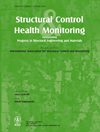A damage identification procedure based on Hilbert transform: Experimental validation
SUMMARY
This paper aims at validating the feasibility of an identification procedure, based on the use of the Hilbert transform, by means of experimental tests for shear-type multi-degree-of-freedom systems. Particularly, a three-degree-of-freedom frame will be studied either numerically or experimentally by means of a laboratory scale model built at the laboratory of the Structural, Aerospace and Geotechnical Engineering Department (DISAG) of University of Palermo. Several damage scenarios have been considered to prove the effectiveness of the procedure. Moreover, the experimental tests have been conducted by considering two different input loads: pulse forces, simulated by means of an instrumental hammer, and wide band noise base inputs, by a shake table.
In the first section the damage identification procedure, proposed in recent works, is presented. The procedure is based on the minimization of an objective function mathematically based on the properties of the analytical signal and the Hilbert transform. Second section reports the experimental model geometrical data and the data acquisition set-up as built in the DISAG laboratory. In Section 3, the results of the experimental campaigns are presented and discussed having considered three damage scenarios. The validated procedure has been proved to be able to not only detect damage even at early stage but it also needs processing of only few samples of the structural response. Copyright © 2010 John Wiley & Sons, Ltd.




